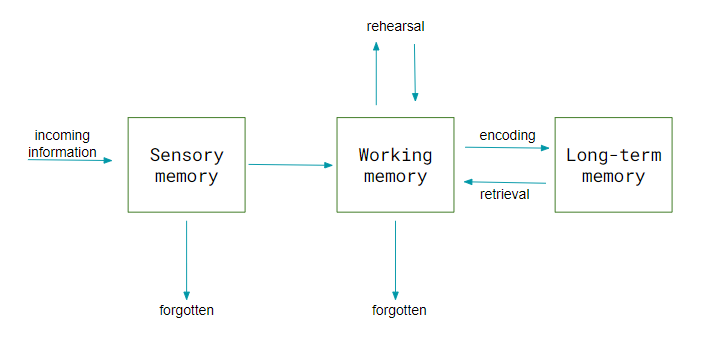I recently conducted a presentation for higher education faculty on improving student learning in online courses. The presentation was based on Sweller’s cognitive load theory (CLT). CLT is an instructional design theory that is interested in reducing unnecessary information complexity in online learning environments. The theory focuses on how the learner receives, processes, stores, and integrates new information in their memory. CLT is specifically concerned with reducing the load of the working memory as the learner acquires new information.
Let’s take a look at the information processing model below!

CLT aims to facilitate the transfer of incoming knowledge into sensory and working memory (WM) first and then encode it into long-term memory (LTM). As a learner develops expertise, they accumulate a large base of knowledge in their LTM. Through retrieval, unlimited amounts of already-learned information can be transferred back in WM, but the new information we can hold in WM is limited (Sweller, 2019). So the question CLT helps us answer is: how do we design and organize online instruction to help the learner be most efficient in processing new information and integrating it with already-learned content?
Types of Cognitive Load
First let’s examine the three types of cognitive load that impact learning. The first is called intrinsic load and it refers to the complexity of the new information presented to the learner. The second is the extraneous load which is the distracting or unnecessary information that accompanies the new information to be learned. An example of this is a presentation slide with lots of pictures, emojis, etc. that distract the learner. The third type of cognitive load is the germane load. This refers to the deep processing of new information and its integration with already-learned material retrieved from LTM. Cognitive overload means that WM is overwhelmed by the intrinsic load and/or the extraneous load. The learner has a reduced ability to learn. The goal is to simplify the intrinsic load and reduce the extraneous load. This way the learner can focus their cognitive resources on the germane load and learning can be more efficient.
Strategies to Reduce the Effects of Cognitive Load
There are many instructional design strategies put forth by CLT to help instructors and instructional designers to reduce the effects of cognitive load.
Worked Example and Completion Task Effect
When teaching new content that consists of a problem formulation and a final solution, such as a math or science problem, it is beneficial to provide worked samples of problems and specific steps on how to solve these problems (Caskurlu, et.al 2021). Students can use these worked samples to solve new problems. Once students are a bit more familiar with a topic, instruction can progress to the completion task effect. This technique provides students with partially-completed examples of problems.
Split Attention Effect
When we present two or more sources of information in an online course, we want our students to view them simultaneously on ‘one page’. No scrolling up and down or clicking through browser tabs! Separating information in time and space, means that the learner has to mentally integrate new information (Caskurlu et al., 2021; Sweller, 2020) . And that is challenging!
Multimodal Presentation Effect
When putting together a presentation, CLT suggests combining two or more communication tools (Sweller, 2020). For example narrating a presentation or including audio/visual along text. The mind processes visual and auditory information separately. Auditory items in WM do not compete with visual items there.
For additional strategies, please check out the following links:
Inner Drive (n.d.) The 10 principles of cognitive load theory. https://blog.innerdrive.co.uk/10-principles-cognitive-load-theory
Krishna, S. (2020, May 18). Cognitive load and coding. Compute Thought. https://computethought.blog/2020/05/18/cognitive-load-and-coding/
Med Ed Models (n.d.) Cognitive load theory. https://www.mededmodels.com/cognitiveloadtheory
Mindtools (n.d.) Cognitive load theory: helping people learn effectively. https://www.mindtools.com/aqxwcpa/cognitive-load-theory
References
Caskurlu, S., Richardson, J. C., Alamri, H. A., Chartier, K., Farmer, T., Janakiraman, S., Strait, M., & Yang, M. (2021). Cognitive load and online course quality: Insights from instructional designers in a higher education context. British Journal of Educational Technology, 52(2), 584–605. https://doi.org/10.1111/bjet.13043
Sweller, J. (2020). Cognitive load theory and educational technology. Educational Technology Research & Development, 68(1), 1–16. https://doi.org/10.1007/s11423-019-09701-3

